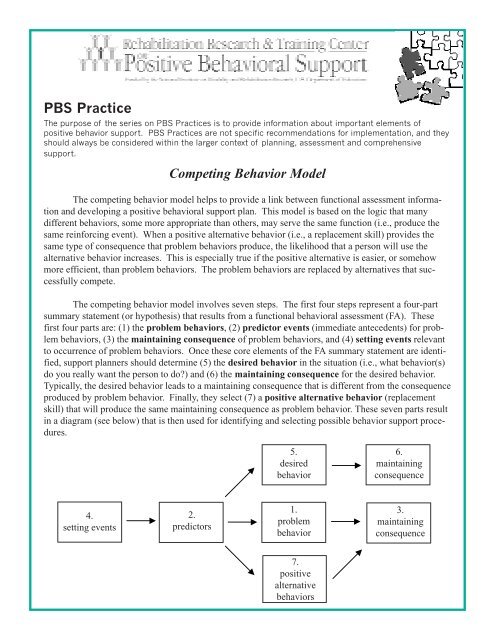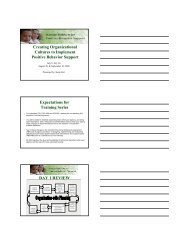PBS Practice Competing Behavior Model - APBS
PBS Practice Competing Behavior Model - APBS
PBS Practice Competing Behavior Model - APBS
Create successful ePaper yourself
Turn your PDF publications into a flip-book with our unique Google optimized e-Paper software.
<strong>PBS</strong> <strong>Practice</strong>The purpose of the series on <strong>PBS</strong> <strong>Practice</strong>s is to provide information about important elements ofpositive behavior support. <strong>PBS</strong> <strong>Practice</strong>s are not specific recommendations for implementation, and theyshould always be considered within the larger context of planning, assessment and comprehensivesupport.<strong>Competing</strong> <strong>Behavior</strong> <strong>Model</strong>The competing behavior model helps to provide a link between functional assessment informationand developing a positive behavioral support plan. This model is based on the logic that manydifferent behaviors, some more appropriate than others, may serve the same function (i.e., produce thesame reinforcing event). When a positive alternative behavior (i.e., a replacement skill) provides thesame type of consequence that problem behaviors produce, the likelihood that a person will use thealternative behavior increases. This is especially true if the positive alternative is easier, or somehowmore efficient, than problem behaviors. The problem behaviors are replaced by alternatives that successfullycompete.The competing behavior model involves seven steps. The first four steps represent a four-partsummary statement (or hypothesis) that results from a functional behavioral assessment (FA). Thesefirst four parts are: (1) the problem behaviors, (2) predictor events (immediate antecedents) for problembehaviors, (3) the maintaining consequence of problem behaviors, and (4) setting events relevantto occurrence of problem behaviors. Once these core elements of the FA summary statement are identified,support planners should determine (5) the desired behavior in the situation (i.e., what behavior(s)do you really want the person to do?) and (6) the maintaining consequence for the desired behavior.Typically, the desired behavior leads to a maintaining consequence that is different from the consequenceproduced by problem behavior. Finally, they select (7) a positive alternative behavior (replacementskill) that will produce the same maintaining consequence as problem behavior. These seven parts resultin a diagram (see below) that is then used for identifying and selecting possible behavior support procedures.5.desiredbehavior6.maintainingconsequence4.setting events2.predictors1.problembehavior3.maintainingconsequence7.positivealternativebehaviors
The basic idea in developing a support plan based on the competing behaviors model is to makeproblem behaviors irrelevant (there is no need to do them), inefficient (there are easier behaviors toengage in), or ineffective (problem behaviors no longer work to produce the desired outcome). Supportplanners identify procedures that will promote and strengthen the links between predictors, positivedesired and alternative behaviors, and their maintaining consequences, and procedures that reduce orweaken the links between predictors, problem behaviors, and their maintaining consequences. Topromote performance of desired behaviors, support planners must ensure that these behaviors have beentaught, and that they produce adequate maintaining consequences (reinforcers) when they occur. Toincrease the use of positive alternative behaviors, an acceptable replacement behavior must first beidentified, and then systematically taught. When this positive alternative behavior occurs, it must producethe same consequence that maintains the problem behaviors. To compete successfully with problembehavior, the positive alternative behavior must be more efficient in producing the desired maintainingconsequence than the problem behaviors that it is replacing.Examples:follow directionscomplete work(desired behavior)teacher praise, bonus“school bucks”(maintainingconsequence)sick / tired(setting events)1:1 instructionsmall group instructionindependent seat work(predictors)mumbles, whispers,head down, slumpedbody, push awayfrom materials, losespencil(problem behavior)escape task demands(maintainingconsequence)ask for a break(positive alternative behaviors)cope withsituationspecific adultpraiseno settingeventsidentifiednew peoplenew situationchange in scheduleno attentionsilly sounds/words& actionsspitsexposes selfpeer & adultattention(high levels/high emotion)ask for adulthelp/attentionask for a peer partner<strong>Competing</strong> <strong>Behavior</strong> <strong>Model</strong>Permission to reproduce this document is granted. Please acknowledge theRehabilitation Research and Training Center on Positive <strong>Behavior</strong>al Support in any reproductions.
Frequently asked questions:1. Can a person have more than one problem behavior summary statement, and, therefore, need morethan one competing behavior model developed? Yes. A competing behavior model should be completedfor each summary statement that results from the functional assessment.2. What if we do not know the setting events? <strong>Behavior</strong> support planning can still occur and be effectiveif relevant setting events are not known. Typically, connections with the individual’s personal life helpto identify relevant setting events for a problem behavior. Observations across living settings, andconversations with people who know the person with problem behavior well, may help to identify andunderstand the setting events that may contribute to the person’s problem behaviors.3. What is the difference between desired and positive alternative behaviors? Aren’t they both justappropriate, positive behaviors? The main difference is in the consequences that these behaviors produce(i.e., their maintaining consequences). The maintaining consequences delivered for “desiredbehavior” are different from the consequences that maintain problem behavior. Because they producedifferent consequences, desired behaviors successfully compete with problem behaviors only when theconsequences for desired behaviors are stronger (more powerful) than the consequences for problembehaviors. Positive alternative behaviors should result in the same maintaining consequences as problembehaviors. Because they produce the same consequences, alternative behaviors serve as acceptablereplacement behaviors for problem behaviors. Alternative behaviors will be used if they are easier to door more efficient than problem behaviors.4. Does using the competing behaviors model to identify positive alternative behaviors guarantee thatproblem behaviors will disappear for good? No. First remember that you may need to teach andprompt an alternative behavior to get it to occur and be reinforced. Also, if alternative behavior does notwork or stops working (i.e., is no longer reinforced), then problem behaviors may return, especially ifthey continue to produce desired outcomes for the person.Other resources:Horner, R. H., Albin, R. W., Sprague, J. R., & Todd, A. W. (2000). Positive behavior support. In M. E.Snell & F. Brown (Eds.), Instruction of students with severe disabilities (5 th Edition) (pp. 207-243).Upper Saddle River, NJ: Prentice-Hall.Horner, R. H., Sugai, G., Todd, A. W., & Lewis-Palmer, T. (2000). Elements of behavior support plans:A technical brief. Exceptionality, 8(3), 205-216.O’Neill, R. E., Horner, R. H., Albin, R. W., Sprague, J. R., Storey, K., & Newton, J. S. (1997). Functionalassessment and program development for problem behavior: A practical handbook. Pacific Grove,CA: Brooks/Cole.<strong>Competing</strong> <strong>Behavior</strong> <strong>Model</strong>Permission to reproduce this document is granted. Please acknowledge theRehabilitation Research and Training Center on Positive <strong>Behavior</strong>al Support in any reproductions.



